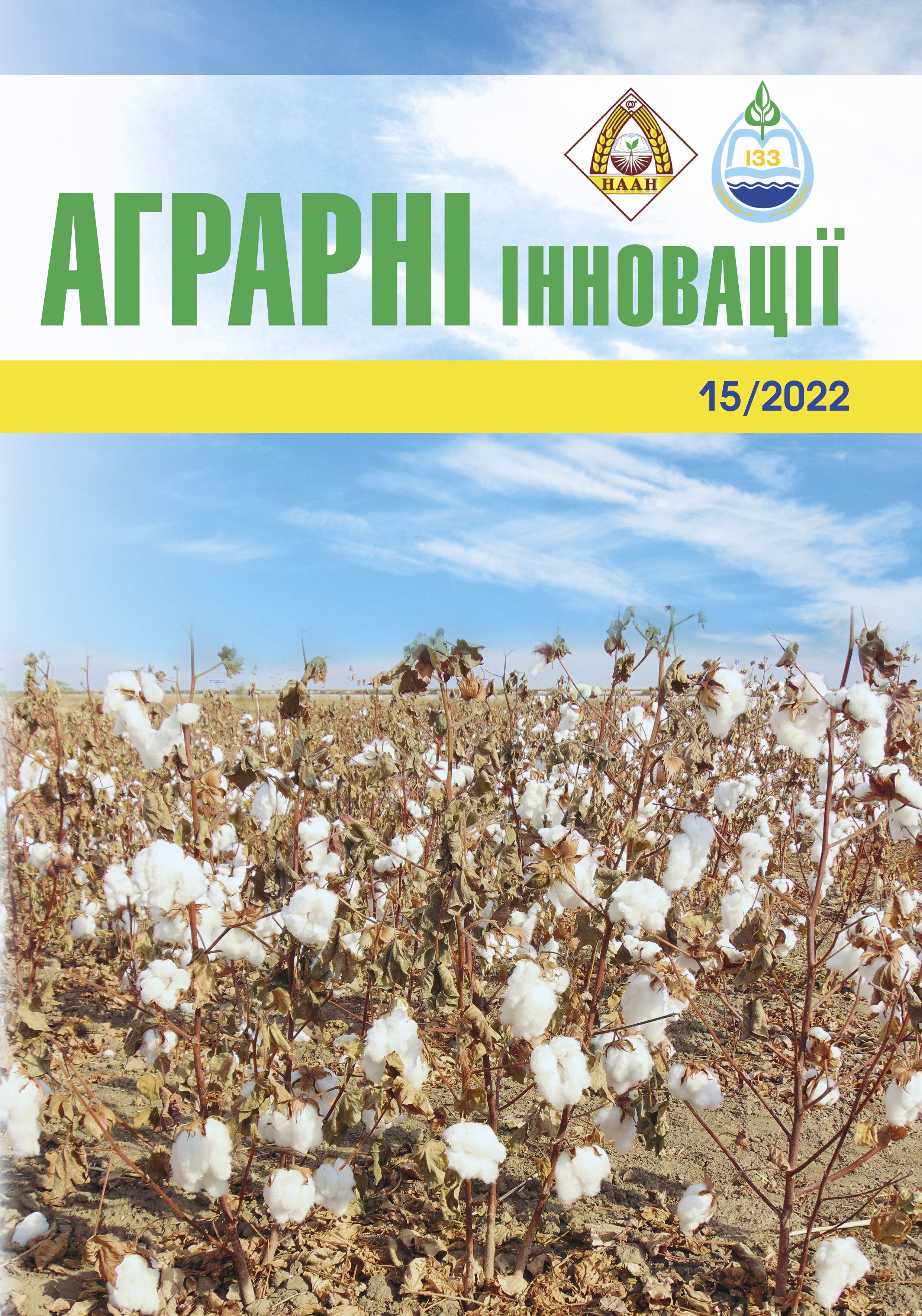Formation of quality indicators of lentil grain depending on pre-sowing seed treatment and foliar fertilization
Abstract
The purpose of the research was to investigate and determine the option of a combined combination of pre-sowing treatment of lentil seeds in interaction with foliar fertilization against the background of appropriate hydrothermal regimes of vegetation for the formation of quality indicators of lentil grain. Methods. The research was conducted during 2019–2021 on the basis of the experimental farm "Agronomichne" of the Vinnytsia National Agrarian University (Agronomichne village, Vinnytsia district, Vinnytsia region) on gray forest soils with medium fertility potential. The experiment was repeated four times. Placement of options is systematic in two tiers. The experiment involved the study of the following factors in relation to their influence on the quality indicators of lentil grain A – the conditions of the growing season; B – inoculation (Anderiz-r (2 l/t)); C – treatment of seeds with microfertilizer (Oracle seeds (1 l/t)); D – foliar feeding (variant of single and combined application) (complex microfertilizers Yarylo active start PRO (2 l/ha) and Avangard Complex Beans (2 l/ha). Results. An increase in the content of crude protein and total nitrogen with a gradual increase in the factors of intensification of the experimental variants was established from the minimum average value during the research period of 27.2% and 4.36% in the variant without the application of additional measures to optimize the nutrition of lentils to 29.7% and 4.69% in the version of a complete and complex combination of them. An increase in the content of crude protein by 0.2–0.3% was determined in the variants of application of seed treatment with microelements and by 0.2%, 0.5% and 0.8% in a number of ways (according to the experimental scheme) of using microfertilizers. The starch content differed between the extreme variants of the experimental scheme by 1.8% with average increases due to inoculation by 0.85%, the use of seed treatment with trace elements by 0.40%, the use of foliar fertilization in a number of ways (according to the experimental scheme), the use of microfertilizers in the experiment by 0.35%, 0.62% and 0.93%, respectively. Crude fiber content had the least pronounced reaction to applied measures to optimize lentil nutrition with a slight increase of 0.12% when comparing the marginal technological options of the experiment. Conclusions. The maximum indicators of the quality of lentil grain are established in the technological variant of the combination of inoculation, treatment of seeds with microelements and two foliar top dressings for the combination of microfertilizers Yarylo active start PRO + Vanguard Complex Legumes – crude protein content 29.7%, total nitrogen 4.69%, starch 55.2% and crude fiber 3.44%.
References
2. Кернасюк, Ю., Полтянкін О., Літковський В. Маржинальні нішеві агрокультури. Агробізнес сьогодні. 2018. №8. С. 12–16.
3. McNeil D. L., Hill G. D., Materne M., Mckenzie B. A. Global Production and World Trade. Lentil: An Ancient Crop for Modern Times / S. S. Yadav, D. L. McNeil, P. C. Stevenson (eds). Dordrecht : Springer, 2007. Р. 95–105.
4. Єремко Л., Лень О. Біб для зернових сівозмін. The Ukrainian Farmer. № 7. 2013. С. 72–74.
5. Кулинич О. О. Сочевиця: розумна альтернатива. Пропозиція. 2004. № 8–9. С. 58–59.
6. Шевченко A. M. Сочевиця – цінна продовольча культура. Луганськ: ТОВ «Знання», 2003. 27 с.
7. Присяжнюк О. І., Топчій О. В., Слободянюк С. В., Карпук Л. М., Маляренко О. А., Павліченко А. А., Свистунова І. В. Сочевиця. Біологія та вирощування : монографія. Вінниця : ТОВ «ТВОРИ», 2020. 180 c.
8. Maggioni L., Ambrose M., Schachl R., Duc G., Lipman E. Lentil in the world. Report of a Working Group on Grain Legumes. Third Meeting 5–7 july. Krakow (Poland), 2002. P. 336–341.
9. Sarker A., Erskine W. Recent progress in the ancient lentil. The Journal of Agricultural Science. 2006. Vol. 144, Iss. 1. P. 19–29.
10. Данильченко О. М., Жатова Г. О. Урожайність і якість насіння кормових бобів та сочевиці залежно від інокуляції бактеріальними препаратами і внесення мінеральних добрив. Вісник Житомирсього національного агроекологічного університету. 2016. № 1 (53). Т. 1. С. 94–101.
11. Присяжнюк О. І., Топчій О. В. Формування елементів структури врожайності сочевиці залежно від строків сівби, мікродобрив і регуляторів росту. Наукові праці Інституту біоенергетичних культур і цукрових буряків. 2017. Вип. 25. С. 72–78.
12. Присяжнюк О. І., Топчій О. В., Калюжна Е. А., Українець В. В. Технологія вирощування сочевиці в умовах Лісостепу України: методичні рекомендації. Київ : Нілан-ЛТД, 2018. 52 с.
13. Каленська С. М., Шихман Н. В. Продуктивність сочевиці залежно від мінерального живлення та передпосівної обробки насіння в умовах правобережного Лісостепу України. Наукові доповіді НУБіП. 2011. Випуск 4 (26). URL: http://www.nbuv.gov.lis/e journals/Nd/2011_4/11ksm.pdf.
14. Сучасна технологія вирощування сочевиці. Науково-виробниче видання. ДУ Інститут зернового госпо
дарства степової зони України. Дніпропетровськ. 2013. 89 с.
15. Методика проведення кваліфікаційної експертизи сортів рослин на придатність до поширення в Україні. Методи визначення показників якості продукції рослинництва. Український інститут експертизи сортів рослин; ред. Ткачик С. О., Києнко З. Б., Присяжнюк Л. М. Вінниця, 2016. 159 с.






